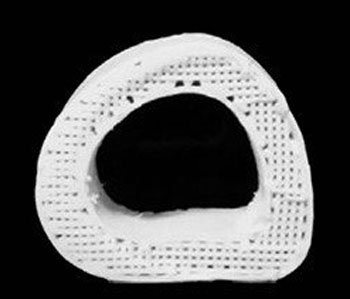Three-Dimensional Printing Generates Bone Replacement Structures
By LabMedica International staff writers
Posted on 14 Oct 2016
A team of biomedical engineers adapted three-dimensional printing to manufacture bone transplant structures whose shape could be easily customized, which would be especially useful for the treatment of bone defects in children.Posted on 14 Oct 2016
Severe deficiencies remain in current bone replacement materials. These limitations include an inability to adequately, rapidly, and reproducibly regenerate new bone; high costs and limited manufacturing capacity; and lack of surgical ease of handling. To correct this situation, investigators at Northwestern University (Evanston, IL, USA) used room temperature three-dimensional printing to generate a new, synthetic bone replacement biomaterial that they called hyperelastic “bone” (HB). This material, which could be extruded in the form of liquid ink, was composed of 90% hydroxyapatite and 10% polycaprolactone or poly(lactic-co-glycolic acid) polymer. Hydroxyapatite is a calcium mineral found naturally in human bone, while the biocompatible, biodegradable polymers are used in many medical applications, including sutures.

Image: A cross-section of an adult human femur produced by three-dimensional printing (Photo courtesy of Dr. Adam E. Jakus, Northwestern University).
The investigators reported in the September 28, 2016, online edition of the journal Science Translational Medicine that three-dimensionally printed HB exhibited excellent elastic mechanical properties, was highly absorbent, supported cell viability and proliferation, and induced osteogenic differentiation of bone marrow-derived human mesenchymal stem cells cultured in vitro over four weeks without any osteo-inducing factors in the medium.
The investigators evaluated HB in vivo in a mouse subcutaneous implant model for material biocompatibility (seven and 35 days), in a rat posterolateral spinal fusion model for new bone formation (eight weeks), and in a large, non-human primate calvarial defect case study (four weeks). HB did not elicit a negative immune response, became vascularized, quickly integrated with surrounding tissues, and rapidly ossified and supported new bone growth without the need for added biological factors.
“Cells can sense the hydroxyapatite and respond to its bioactivity,” said senior author Dr. Ramille N. Shah, assistant professor of materials science and engineering at Northwestern University. “When you put stem cells on our scaffolds, they turn into bone cells and start to up-regulate their expression of bone-specific genes. This is in the absence of any other osteo-inducing substances. It is just the interaction between the cells and the material itself. We can incorporate antibiotics to reduce the possibility of infection after surgery. We also can combine the ink with different types of growth factors, if needed, to further enhance regeneration. It is really a multi-functional material.”
“Adults have more options when it comes to implants,” said Dr. Shah. “Pediatric patients do not. If you give them a permanent implant, you have to do more surgeries in the future as they grow. They might face years of difficulty.”
Related Links:
Northwestern University







 assay.jpg)






